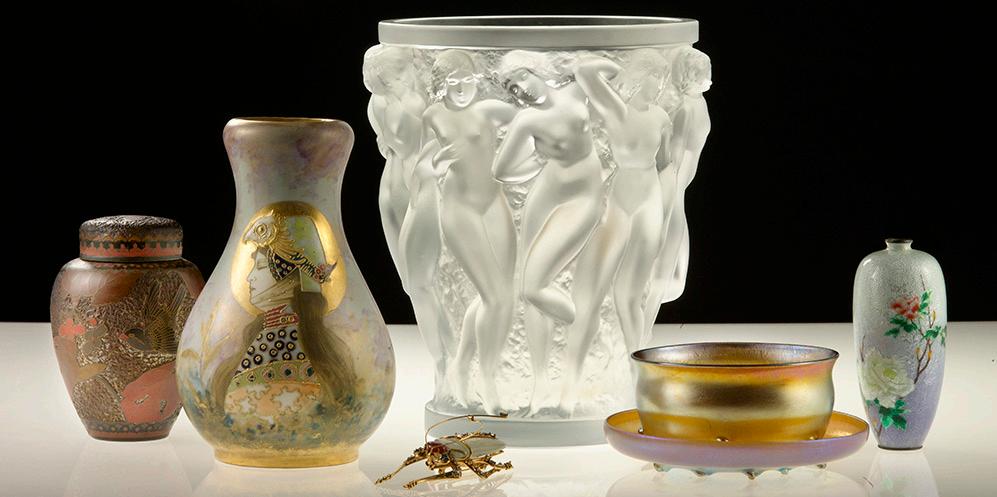
5 minute read
From Trash to Treasure: The Syl-Lee Guide to Antiques
From bedside tables and vases to jewelry and coins; you may have some hidden gems within your home!
By BEVERLY FORTUNE
“I think it’s garbage, but my mother insists it’s not,” is what Adam Zimmerman, owner of Syl-Lee Antiques often hears from families when going through their home’s contents.
We’ve all heard stories of people getting rich from the sale of rare memorabilia or antiques that they had in their home, but antiques and collectibles are subject to the same trends as anything else. People want something that no one else has. In the antique world, demand and availability typically drives the price, just like anything else, and is only worth what a buyer is willing to pay.
So, how can you tell if an item is valuable and if it is, how do you sell it and get the best deal?
For the average person, it’s not easy to eyeball an item and determine if it has any value. If you’re redecorating, cleaning out your home, moving or downsizing, or if you’re just plain curious about its value, it’s a good idea to have an expert determine if you’re really sitting on a pile of cash.
Do Your Homework
Before you make that call, you can do some research on your own to see if you have an antique or collectible.
Antiques are generally classified as being at least 100 years old and are defined by their authenticity and rarity.
A collectible is typically 50 years old or less and most often something that was mass-produced for the purpose of collecting. They are also defined by rarity and celebrity, which includes memorabilia, baseball cards and toys.
Sometimes people who do their own research can make mistakes, especially when it comes to art work.
Call An Expert
When you’re ready to find out if your items are worth anything, the easiest option is to call an antique expert who will come to your home, instead of traipsing your potential windfall to their store.
“Piece of mind,” that’s why people call me, says Adam Zimmerman of SylLee Antiques. The company is named after Zimmerman’s grandparents, Sylvia and Lee, and, even though a large part of their business is going into people’s homes, Syl-Lee also has a brick and mortar store at 40 W. 25th Street in New York City.
Syl-Lee is still a family affair. Zimmerman works closely with his sisters, Marnie and Marion.
Marnie receives the texts and emails of items from potential clients, which are passed on to Marion, who usually goes on the house calls with Adam.
“Once you learn what’s valuable and what’s not, you can decide if it has sentimental value and keep it, donate it or discard it,” he says.
“The Chinese stuff is the most difficult to research yourself, because an original and reproduction can look exactly alike. The mark on the piece could say it’s 200 years old, and it was really made yesterday. I’ve been doing this a long time, and I can tell the difference,” Zimmerman says.
The Syl-Lee business model sounds something like an episode of the hit television show Pawn Stars.
“I have an expert in just about every field, including Russian and Judaic art, and my Asian expert speaks Mandarin. In this business you can’t know everything, so I have experts to assist me.”
“You don’t have to call multiple auction houses or bring your stuff to the Antique Roadshow. I can have my experts on the phone in minutes or they will come to your house if warranted,” he says.
Zimmerman says he offers his clients options like cash on the spot, or he can get the items into one of about 15 different auction houses he typically works with, like ones that specialize in glass, Asian, collectibles, sports memorabilia, cartoon artwork, stamps and comics.
“You don’t want to put a specific item in a general auction because it can get lost. I try to connect the dots and put the right items in the right auction or into a specialist’s hands,” he says.
Zimmerman also cautions people who are researching the value of their items on the internet.
“Usually high retail prices come up in a search. You might see that someone is asking $2,000 for an item. You have to look at the sold items and make sure that the item actually sold for that price and that they didn’t take the best offer. I can give a more realistic result.”
Zimmerman also says that coins are another tricky market.
“You can have a Morgan silver dollar from the 1890s that was kept in plastic, and if it’s graded, that $20 coin could be worth $1,000 if it’s in perfect condition.”
WHAT’S HOT & WHAT’S NOT
Not
The markets for Hummels and Lladros are next to dead, Zimmerman says.
“What happens is the kids don’t want these items anymore. Grandma used to display them and she would dust them every day. This is a ‘less is more’ generation. They don’t want curio cabinets and breakfronts filled with collectibles.
If it doesn’t have a functional purpose, it’s not wanted. Hummels were mass produced so they are really not a rare item.
Hot
One of the biggest markets that has turned around is mid-century modern furniture. “It’s really strong right now,” Zimmerman says.
“1950s is the style people are looking for. In my world, the important names to look for are Herman Miller, Nakashima, George Nelson, and some Danish modern from American furniture designer Vladimir Kagan. You can hit a homerun with Danish modern furniture and Chinese antiques,” he says.
Hot
“Costume jewelry is very popular right now. People don’t want to wear yellow gold as much – so you might have a jewelry box full of fake jewelry and in reality, there could be a lot of money there,” Zimmerman says.
Zimmerman added, “In general, the bigger and gaudier, the better. You’re not going to get rich on one piece, but there are collections with big pieces from Trifari, Truffaut, Monet or Miriam Haskel. The biggest is Chanel. All of these pieces might be fake, but if it’s old enough, you could get lucky. The bigger and flashier the better.”
HOT Zimmerman cautions that there are certain categories of antiques that you should consult an expert about.
“Chinese antiques is a strong market,” he says and adds, “Japanese, Korean and Thai are not a hot market, but Jade, coral, amber, Chinese porcelain and paintings are, so it can get really tricky.
Every category has something valuable in it. For example, I would say pottery is not a great market in general, but I just sold a piece for $20,000.”
HOT Zimmerman says you can get lucky with artwork, but it doesn’t matter if you have a beautiful piece of art, it matters who the artist is.
He explains, “People are buying art for investment first – then beauty. There are artists from the 70s and 80s that are becoming very popular right now.”
Some valuable artwork that you might find in your home might be a limited-edition Andy Warhol print that’s worth tons of money or a limited-edition print by Keith Haring – an American artist whose pop art emerged from the New York City graffiti subculture of the 1980s.
There’s an artist named Richard Pettibone who made mini copies of Warhol’s and Lichtenstein’s art in the 70s that you could buy for a couple of hundred dollars.
“Now, they are now selling for $10,000 to $20,000 a piece. At an auction recently someone got $50,000 for a few of them.”
“It looked like nothing, and now it can be sold for thousands,” Zimmerman says. That's why he always hears: “I think it’s garbage, but my mother insists it’s not.”
For more information call (516) 671-6464, email contact@syl-leeantiques.com or visit www.Syl-LeeAntiques.com








